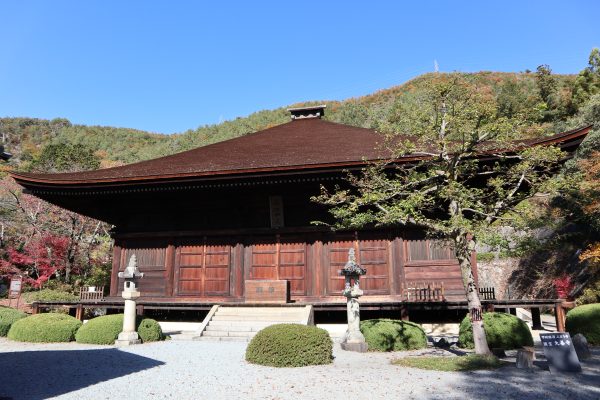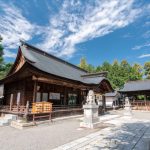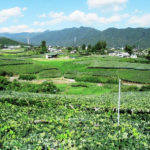

While meditating one night, Gyōki, a great priest of the Nara period (710-794), had a
vision of Yakushi Nyorai, the Buddha of Medicine and Healing, holding a cluster of
grapes. Soon after, in 718, Gyōki carved a statue of the Buddha from his vision and
founded Daizen-ji Temple. Hence, the temple has come to be known as “Budo Dera,”
“The Temple of Grapes” . Having received a royal command by Emperor Shōmu
under a national policy known as Chingo Kokka (pacifying and protecting the nation),
Daizen-ji Temple enjoyed great prosperity during the Heian period (794 -1185), growing to
having as many as 52 halls and quarters for 3,000 priests. However, over the course of its
long history, the temple endured numerous disasters that destroyed many temple
structures. What remains of Daizen-ji Temple’s past is currently stored at Yakushi-do (the
main hall) which was constructed in 1286 using donations collected from residents of
Yamanashi and Nagano Prefectures. The most impressive items held in the temple’s
collection are the colorful Jūni Shinshō (Twelve Heavenly Generals).
The San-mon (main gate), which leads to the main hall, was reconstructed in 1798.
Although the gate features in a famous woodblock print of The Battle of Kōshū-
Katsunuma created by Tsukioka Yoshitoshi, the battle actually took place just to the east
of the temple precincts on March 29,1868.
The ”Kōshū” Grape
Grapes, which are not native to Japan, almost certainly arrived here via the Silk Road
through China. Analyses of DNA have revealed that the modern Kōshū grape of Japan, a
grape used in making white wines, is actually a hybrid of grapes found in the Caucuses
region near the Caspian Sea and wild varieties found in China. According to local legend,
Gyōki, the great priest who founded Daizen-ji Temple in 718, cultivated the land, which is
not suitable for growing rice, for vineyards
and taught the locals how to grow grapes. Another legend says grape vines were
discovered and greatly improved by Kageyu Amemiya during the Kamakura period
(1185-1333).
Rikei-ni
Rikei-ni, a cousin of Takeda Shingen, one of the most formidable warlords of Japan’s
Warring States period, lived as a nun at Daizen-ji Temple and is most notable for her
military history, Rikei-ni Ki (Nun Rikei’s Account).
Being pursued by the combined forces of Oda Nobunaga and Tokugawa Ieyasu, the
fourth son of Takeda Shingen, Takeda Katsuyori, spent a night at Daizen-ji Temple praying
for his family to be reunited in the afterlife. Subsequently, Katsuyori and his forces were
outnumbered and outmatched by their opponents in the ensuing battle, The Battle of
Tenmokuzan. Rikei-ni, who had nursed Katsuyori as an infant, pitied the fate of the
Takeda clan, so she wrote Rikei-ni Ki (Nun Rikei’s Account) in order that the names of the
Takedas could at least be remembered. Ultimately, 37-year-old Katsuyori, his 19-year-old
wife, his 16-year-old son from another marriage, and about 60 officers, soldiers and
maids committed ritual suicide on March 11, 1582. This act marked the official end of
three generation of Takeda domination of the central part of the Japanese archipelago.



